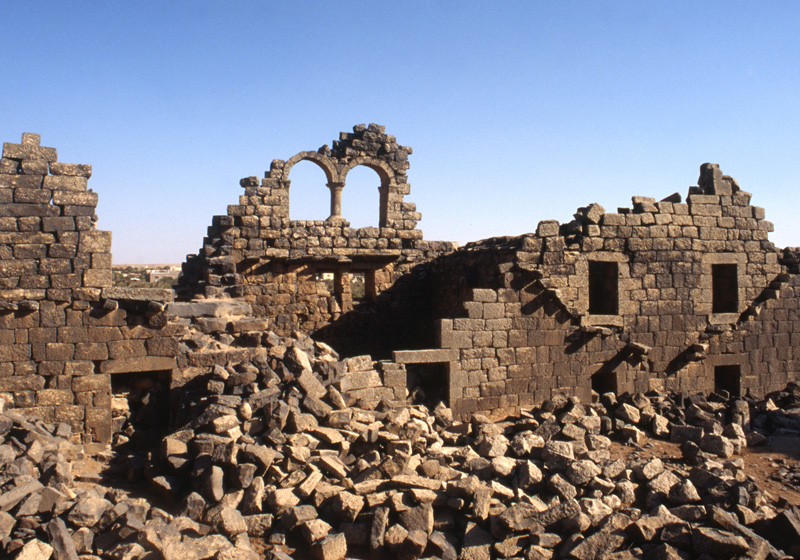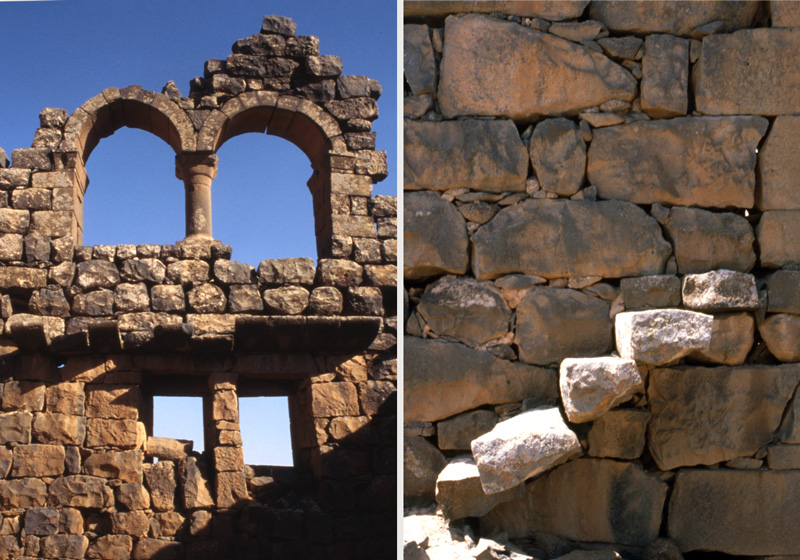Corbels Adrift
Basalt is an igneous rock. Unlike the white limestone of Amman that was formed as sediment of ancient seas, hence the name “sedimentary rock”, basalt was brought up on the surface of the landscape by volcanic eruptions. This igneous stone was, once in the past, fluid or semi-fluid lava, oozing and cooling to form the attractive blue-black stone that forms the basalt plateau of the Northeastern parts of Jordan.
Out of basalt, this black majestic stone, impressive monuments were built. There are wonderful villages at Houran in Syria with their almost intact Roman and Byzantine buildings. In Jordan there are many locations where monuments in basalt can be seen. Besides the more famous sites, such as Umm Al Jimal and Azraq Castle, there are less known sites and small villages where one can discover pleasing little sites, such as in the villages of Baa’ij, Dair Al Kahf, Jawa and Dair Al Qinn.

Umm Al Jimal is by far Jordan’s largest historical site of basalt stone. The old city covers about 500m by 700m of land and has at least 100 structures that were built as houses, churches, barracks, and reservoirs. What makes this city interesting for visitors and archaeologists is its collection of houses. Unlike Jerash, where the lack of homes remains makes it almost impossible to construct a meaningful picture of daily life of ordinary people, Umm Al Jimal is blessed with great telling examples of private houses; the most important of which is the “Sheikh’s House” in the southeastern side of the city.
Built in the typical manner, around a courtyard, it shows the surprising use of basalt as cantilevered staircases leading to doorways that were often three floors high. Builders of Umm Al Jimal knew fully the strength of their black stone. The same qualities that made this stone difficult to shape, gave is an ability not found in limestone, the ability to withstand tension. With this strength, unusual to other types of stone, the basic building block can resist some pulling (tension) instead of only compression as usual. In many ways basalt stone in Umm Al Jimal was used in the same manner as steel beams or steel-reinforced concrete are today. This use is very logical for a stone full of metals brought up as magma from the inner furnace of the earth several kilometers below.

Corbels and cantilevers can be seen here performing different duties. These stone beams, held at one end, are used for stairs on the outside of walls and as layered corbels inside the rooms. The spanning of roofs in Umm Al Jimal is a feature to recognize. Taking the tension possibilities to the limit, corbels are layered to reach very close to the center of the span, close enough to jump the remaining gap using one stone as a beam resting on corbels at each end. The elegance of these narrow stones, 30cm wide and 20cm thick, is the result of their unusual lengths reaching in some instances to 2.7 meters.
So good was the utilization of tension in this stone that it was made to work as tie-rods in walls, to prevent the building from collapsing outwards. In a few spots a course of interlocking U-shaped stones can be seen, such a treatment meant that stones were placed there as a belt, a duty that is usually given only to rods of steel.
Umm Al Jimal, this Roman, Byzantine, and Islamic city remains an amazing witness of how a specific building material can lead the designing process, stone as the chief architect, and how a dialogue between the materials of the site and the needs of its inhabitants can lead to results of creative harmony.
Umm Al Jimal, appropriately short on ornaments, is a lasting lesson on structural design, a lecture for the mind and a sculpture for the eye.
Good for the winter when the desert sky gets animated with clouds. Easy drive, suitable for children and can be combined with a visit to other sites such as Qasr Al Hallabat, Hammam Al Sarah, and a number of small villages on the “basalt plateau”. Umm Al Jimal can be reached without any off-road driving. From Amman you can take the “Zarqa Autostrad”, exit before Zarqa on the highway to Mafraq, follow the signs of the University Umm Al Jimal some 15km east of Mafraq. Take some sandwiches or you can buy a can of tuna, a lemon and fresh bread from the nearby village.